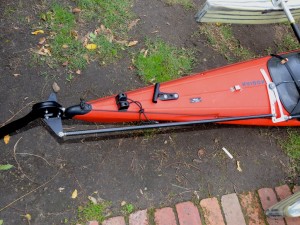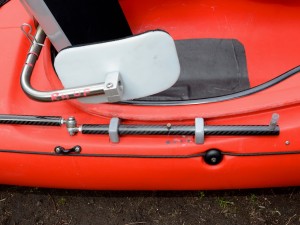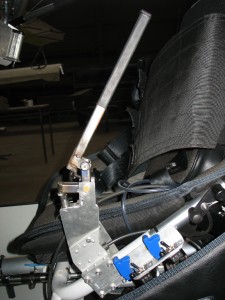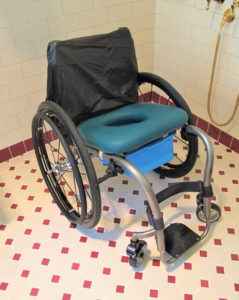Modifications
Prijon Kodiak Kayak

The Prijon Kodiak kayak is a 5.2m plastic sea kayak with an efficient cruise speed and large keyhole cockpit opening – allowing easy access for someone with a disability, or the larger paddler. Direction is controlled by a foot-operated rudder. Dave has designed and developed adaptations to allow him to paddle it independently.
Adaptations:
- Paddle – Dave has no finger function and cannot grip the paddle. Dave tapes his hands to the paddle, pulling his fingers around to form a grip.
Dave also uses a Werner Athena paddle as it has a smaller blade. This enables him to paddle with a higher cadence (faster) but with less stress on his shoulders increasing his paddling endurance and reducing fatigue.
- Stability – Due to Dave’s lack of balance, he cannot stop the kayak from rolling over. Fiberglass / carbon fibre outriggers have been developed with sufficient buoyancy to prevent the kayak from rolling while leaning over the side. The outriggers can be adjusted closer to the hull, or further out, to provide the required level of stability.
- Seating – A high backrest was developed with lateral supports to provide Dave with sufficient trunk support and balance. A Roho (air) cushion sits on the floor of the kayak to provide good pressure relief on his bum, also providing a lower centre of gravity assisting with stability.
- Rudder – The rudder is usually controlled by the feet. Dave modified the rudder incorporating a sip/puff system with an electric actuator (motor) to turn the rudder left and right. By sipping on a tube in Dave’s mouth the rudder turns left, puffing turns it right. The actuator is connected to a carbon fibre rod mechanism that runs on the outside from the cockpit to the rudder. If the electric system fails the rudder can be operated manually by sliding the rod forward and backwards operates the rudder.
Jabiru J230

The Jabiru J230 is 3-axis fixed wing recreational aircraft. Dave has designed and developed various adaptations for the jabiru J230 aircraft to allow him to fly it independently with quadriplegia.
Adaptations:
- Speed of the aircraft – the speed of the engine is controlled by sipping or puffing on a tube in his mouth. Sip throttles the engine down, by puffing throttles the engine up.
- Steering – the aircraft is steered using both hands. Hand attachments are used to allow Dave to grip the levers without finger function.
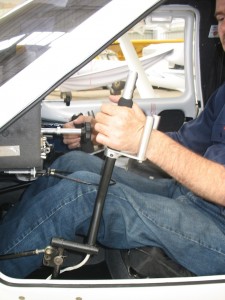
The rudder is controlled with his left hand by hand lever by pushing it forward or backwards. No foot control is required for the rudder which is used to keep the aircraft flying straight.
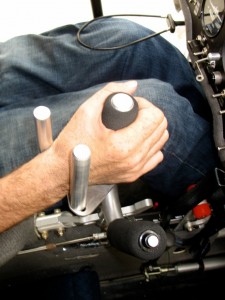
The pitch and roll is controlled with the control column on his right hand, push it forward or back to lower or raise the nose of the aircraft. Pushing the control column left or right banks the aircraft left or right.
- Other adaptations – various adaptations have been developed for use without finger function such as brakes, trim & flap control, and instruments.
- Access – Dave uses a small scissor lift to raise his wheelchair up to the height of the aircraft so he can get in with assistance. The lift folds down and is stored in the cargo compartment of the aircraft.
For more information about the adaptations download the report.
To see Dave in action flying the Jabiru J230 with his adaptations, watch this video:
Microlight Trike XT-912
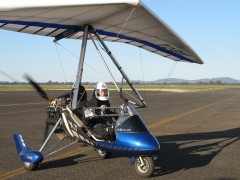
Dave designed and developed various adaptations for the Microlight trike XT-912 to allow him to fly it independently with quadriplegia.
The trike is a weight shift aircraft, by shifting the weight of the pod that hangs below the wing from side to side turns the aircraft. By speeding up the engine or slowing it down make the aircraft climb and descend. The trike is steered on the ground using feet to turn the front wheel left & right.
Adaptations:
- Steering the aircraft in the air – the aircraft is steered in the air by pushing a horizontal bar (base bar) left and right. As Dave cannot gip the base bar as he has no finger function, he uses a control bar adaptation that bolts to the base bar allowing him to lock his hands in place, allowing him to steer.
- Steering the aircraft on the ground – the aircraft is steered on the ground by controlling the front nose wheel. Dave has a tube in his mouth and by sipping and puffing turns the front wheel left and right. The front wheel will self-centre once the input has been removed.
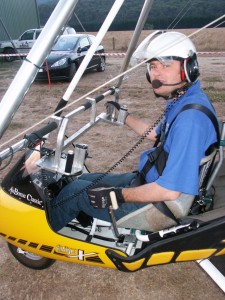
Dave’s earlier trike used a hand lever for ground steering (shown here in his left hand). This was found to be unsuitable and dangerous when it was moderately windy, therefore the sip/puff systems was developed. Refer to the Edge X – 582 Adaptation Report (link provided below) for further information.
- Speed of the aircraft – the speed of the engine is controlled by two push button switches on the control bar adaptation. Pressing the left one throttles the engine down, the right throttles the engine up.
- Other adaptations – various adaptations have been developed for use without finger function such as hand lever to operate the brakes, strengthened back rest with chest belt to hold Dave in, modifications to the radio, switches and instruments.
For more information about the adaptations, download the reports:
Conversion – Wheelchair to Commode

One of the biggest challenges Dave has travelling is the amount of equipment needed, and transporting a big, heavy commode can be very difficult when weight or space is a problem. To overcome this Dave has developed a simple lightweight kit (weighs 2kg) that converts his wheelchair into a commode, able to be used for toileting and in the shower.
Dave’s travel kit includes:
1. Padded Toilet Seat. – The padded toilet seat is an off-the-shelf product that Dave simply modified by installing an aluminium support bracket at the rear and plastic clips at the front.
To install the seat, the seat upholstery on Dave’s wheelchair is removed by undoing the Velcro straps allowing the seat upholstery to be folded back behind the backrest. Once this is done, the padded toilet seat then securely clips on top of the wheelchair frame.
2. Toilet Seat Bowl – The bowl clips onto the plastic rails on the underside of the toilet seat.
When Dave goes camping he puts a biodegradable plastic bag inside the bowl to contain the contents. It can then be either put down a toilet or buried.
3. Plastic Garbage Bag – When showering Dave puts a plastic bag over the back upholstery (& seat upholstery folded up at the back) to protect it from getting wet. This can also be reused several times. Hint: don’t use the perfumed bags!
4. Portable Shower Hose – Not all motels/caravan parks have wheelchair assessable bathrooms or showers. Dave takes a portable shower hose to get him out of trouble. If the accommodation has a floor waste in the bathroom or even in a laundry the shower hose is easily connected to the spout on the sink taps, enabling Dave to still have a shower in many inaccessible places.
Note: The bearings in the casters and wheels may need to be replaced more frequently if you plan to use the wheelchair in the shower often.





